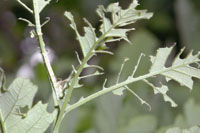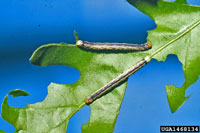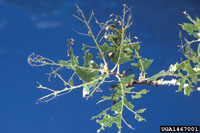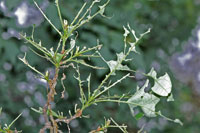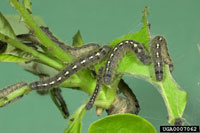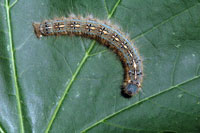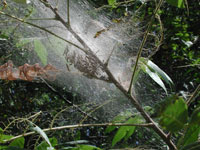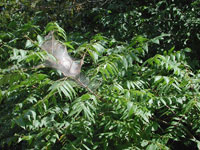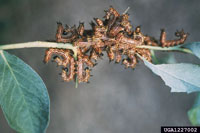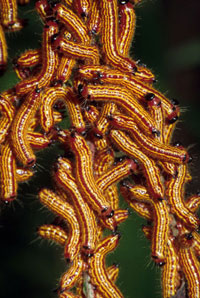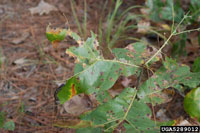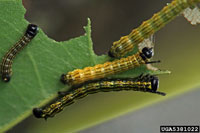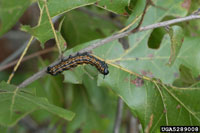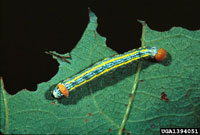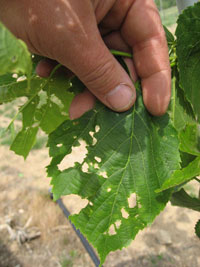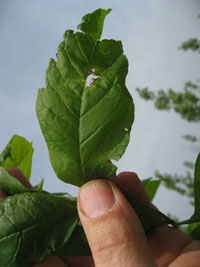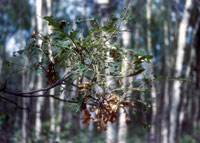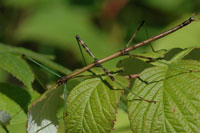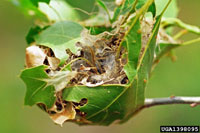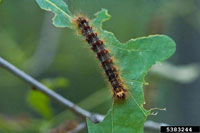Extension > Garden > Diagnose a problem > What's wrong with my plant? > Deciduous Trees > Oak > Holes in leaves or parts of leaves missing
Oak > Leaves > Holes in leaves or parts of leaves missing
1 of 10
Cankerworms
Alsophila pometaria (fall) and Paleacrita vernata (spring)
- Larvae chew between the major veins at first, eventually chewing everything except midveins
- Defoliation typically light to moderate, although it can be severe
- Smooth-bodied, light green to brown, 2 inches long when fully grown; moves in characteristic looping motion
- Damage occurs late April/early May until June
- More information on Cankerworms
2 of 10
Forest tent caterpillar
Malacosoma disstria
- Larvae chew entire sections of leaves, sometimes leaving some major veins; defoliation often severe
- Blue and black with characteristic footprint shaped white markings on top of body
- Damage occurs May and June
- More information on Forest tent caterpillars
3 of 10
Fall webworm
Hyphantria cunea
- Produces silken webbing that covers the ends of branches
- Chews entire sections of leaves, leaving major veins and can defoliate trees in high infestations
- Yellowish or greenish with long, fine white hairs with two rows of black spots down its back; approx. 1 inch long at maturity
- Damage occurs from late July through September
- More information on Fall webworms
4 of 10
Yellownecked caterpillar
Datana minnistra
- Young larvae feed in groups and skeletonize leaves by eating the leaf tissue and leaving the veins.
- As larvae mature, they become solitary feeders and eventually eat the entire leaf.
- Larvae are active from late July through early September.
- They have black heads with striped body covered with fine white hairs and a bright yellow spot behind the head.
- More information on Yellownecked caterpillar
5 of 10
Orange-striped oakworm
Anisota senatoria
- Young larvae skeletonize leaves, i.e. eat the leaf tissue between the veins so that it appears lace-like, gregariously (in groups)
- Older larvae usually defoliate one branch at a time, eating entire leaves, except the central vein; less gregarious compared to young larvae
- Young larvae greenish-yellow, older larvae are black with orange; 2 “horns” just behind the head; two inches when fully grown
- Feeding during late July, August, and into September
- White oak species is a preferred host
- More information on Orange-striped oakworm
6 of 10
Redhumped oakworm
Symmerista canicosta
- Larvae eat leaves and can defoliate branch
- Light colored body with red head with orange-red hump near back end; approx. 1 ¾ inch long
- Damage common in late summer
- White and bur oak are preferred hosts
- More information on Redhumped oakworm
7 of 10
June beetle
Phyllophaga spp.
- Adults eat leaves, preferring young, tender leaves
- Chocolate brown to black; ½ to 1 inch long, oblong; shiny, hard bodies; last several segments of antennae asymmetrical and comb-like
- Active May into July
- More information on June beetle
8 of 10
Walkingstick
Diapheromera femorata
- Eat leaves; can defoliate trees
- Wingless, stick-looking insects with long thin legs and antenna; grows up to 3 inches long; color ranges from brown to green
- Damage seen in late July and August
- More information on Walkingstick
9 of 10
Oak webworm
Archips fervidanus
- Hide inside rolled leaves which fill with frass and leaf pieces
- Larvae eat leaves and can defoliate branches
- Up to 1 inch long; black head and yellowish to dark green body
- Black and red oak are preferred hosts
10 of 10
Gypsy moth
Lymantria dispar
- Chew leaves and can defoliate entire trees
- Mature larvae are 2 inches long; upper side has five pairs of blue dots near front of body followed by six pairs of red dots down the back
- Damage occurs in June and July
- Is currently a federally quarantined pest in Minnesota; not established in Minnesota; if found, contact Arrest the Pest: 1-888-545-6684 or Arrest.the.Pest@state.mn.us
- More information on Gypsy moth



